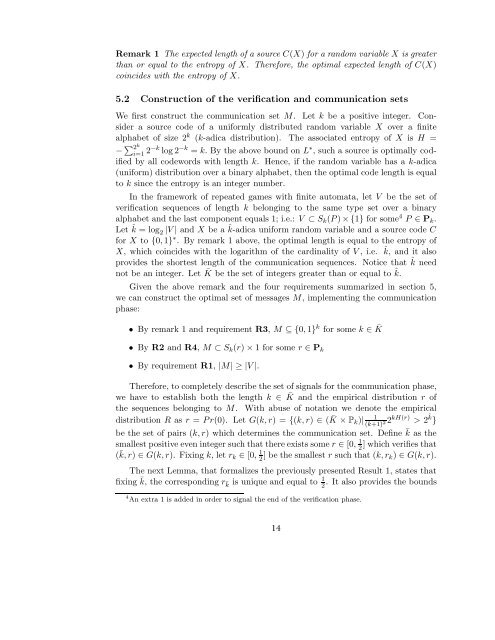CODIFICATION SCHEMES AND FINITE AUTOMATA ... - Ivie
Create successful ePaper yourself
Turn your PDF publications into a flip-book with our unique Google optimized e-Paper software.
Remark 1 The expected length of a source C(X) for a random variable X is greater<br />
than or equal to the entropy of X. Therefore, the optimal expected length of C(X)<br />
coincides with the entropy of X.<br />
5.2 Construction of the verification and communication sets<br />
We first construct the communication set M. Let k be a positive integer. Consider<br />
a source code of a uniformly distributed random variable X over a finite<br />
alphabet of size 2 k (k-adica distribution). The associated entropy of X is H =<br />
− ∑ 2 k<br />
i=1 2−k log 2 −k = k. By the above bound on L ∗ , such a source is optimally codified<br />
by all codewords with length k. Hence, if the random variable has a k-adica<br />
(uniform) distribution over a binary alphabet, then the optimal code length is equal<br />
to k since the entropy is an integer number.<br />
In the framework of repeated games with finite automata, let V be the set of<br />
verification sequences of length k belonging to the same type set over a binary<br />
alphabet and the last component equals 1; i.e.: V ⊂ S k (P) × {1} for some 4 P ∈ P k .<br />
Let ˆk = log 2 |V | and X be a ˆk-adica uniform random variable and a source code C<br />
for X to {0,1} ∗ . By remark 1 above, the optimal length is equal to the entropy of<br />
X, which coincides with the logarithm of the cardinality of V , i.e. ˆk, and it also<br />
provides the shortest length of the communication sequences. Notice that ˆk need<br />
not be an integer. Let ¯K be the set of integers greater than or equal to ˆk.<br />
Given the above remark and the four requirements summarized in section 5,<br />
we can construct the optimal set of messages M, implementing the communication<br />
phase:<br />
• By remark 1 and requirement R3, M ⊆ {0,1} k for some k ∈ ¯K<br />
• By R2 and R4, M ⊂ S k (r) × 1 for some r ∈ P k<br />
• By requirement R1, |M| ≥ |V |.<br />
Therefore, to completely describe the set of signals for the communication phase,<br />
we have to establish both the length k ∈ ¯K and the empirical distribution r of<br />
the sequences belonging to M. With abuse of notation we denote the empirical<br />
1<br />
distribution R as r = Pr(0). Let G(k,r) = {(k,r) ∈ ( ¯K × P k )| 2 kH(r) > 2ˆk}<br />
(k+1) 2<br />
be the set of pairs (k,r) which determines the communication set. Define ¯k as the<br />
smallest positive even integer such that there exists some r ∈ [0, 1 2<br />
] which verifies that<br />
(¯k,r) ∈ G(k,r). Fixing k, let r k ∈ [0, 1 2 ] be the smallest r such that (k,r k) ∈ G(k,r).<br />
The next Lemma, that formalizes the previously presented Result 1, states that<br />
fixing ¯k, the corresponding r¯k is unique and equal to 1 2<br />
. It also provides the bounds<br />
4 An extra 1 is added in order to signal the end of the verification phase.<br />
13

















